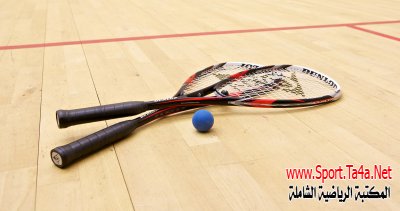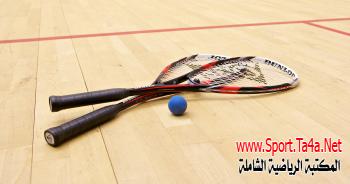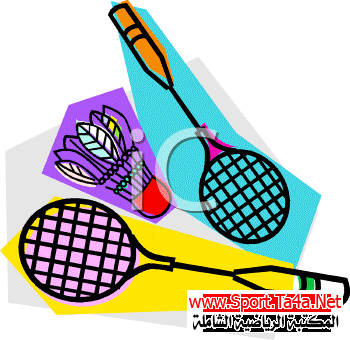Squash
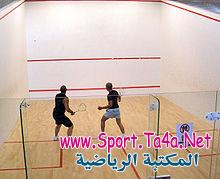
Squash is a racquet sport played by two players (or four players for doubles) in a four-walled court with a small, hollow rubber ball. Squash is recognised by the IOC and remains in contention for incorporation in a future Olympic program.
The game was formerly called squash racquets, a reference to the "squashable" soft ball used in the game (compared with the fatter ball used in its parent game racquets (or rackets; see below).
History
Squash developed from at least five other sports involving racquets, gloves, and balls having roots in the early 16th century in France.[1]It is stated that “Squash, with its element of hitting balls against walls, was for entertainment. For example, boys and girls slapped balls in narrow alleys and streets”.[1] Religious institutions in France, such as monasteries, developed a similar game. Monks used gloves that were webbed to hit balls against a fishing net strung across the middle of the courtyards of the monasteries.[1] This developed the early “racquets” used in tennis and squash. Then in late fifteenth century, tennis was developed and spread to other European nations. The next major development of squash took place in England where the game of "racquets" was developed in Fleet Prison, a debtor’s prison.[1] Similar to tennis, it involved racquets and balls, but instead of hitting over a net as in tennis, players hit a non-squeezable ball against walls. A variation of rackets that also led to the formation of squash was called fives, similar to handball. Fives was essentially the game of racquets, without racquets. (The ball was hit with the hand.)[1] It is played against a wall or walls.
These games gained popularity in schools, and squash itself was developed in a school, Harrow School in England.[2] The first courts built at this school were rather dangerous because they were near water pipes, buttresses, chimneys, and ledges. The school soon built four outside courts. Natural rubber was material of choice for the ball. Students modified their racquets to have a smaller reach to play in these cramped conditions.[1]
The racquets have changed in much the same way as those used in tennis. Squash rackets used to be made out of laminated timber. In the 1980s, construction shifted to lighter, carbon-based materials (such as graphite) with small additions of such components as Kevlar, boron and titanium. Natural "gut" strings were replaced with synthetic strings.
In the 20th century the game increased in popularity with various schools, clubs and even private citizens building squash courts, but with no set dimensions. The first squash court in North America appeared at St. Paul's School in New Hampshire in 1884. In 1904 in Philadelphia, Pennsylvania, the earliest national association of squash in the world was formed as the United States Squash Racquets Association, (USSRA), now known as US-Squash. In April 1907 the Tennis, Rackets & Fives Association set up a sub committee to set standards for squash. Then the sport soon formed, combining the three sports together called “Squash”. It was not until 1923 that the Royal Automobile Club hosted a meeting to further discuss the rules and regulations and another five years elapsed before the Squash Rackets Association was formed to set standards for squash in Great Britain.[1]
The sport spread to America and Canada, and eventually around the globe. Players such as F.D. Amr Bey of Egypt dominated the courts in the 1930s, Geoff Hunt of Australia dominated the game during the 1960s and 1970s winning a record eight British Opens at the time and during the 1980s and 1990s Jahangir Khan of Pakistan won the British Open a record of ten times and Jansher Khan of Pakistan won the World Open a record of eight times.[2] No list of squash champions is complete without referencing the legendary Pakistani Hashim Khan, winner of 7 British Open championships, and his son, Sharif Khan, winner of 12 North American Open titles. Hashim is considered one of the best athletes of all times and is the patriarch of a sports dynasty, consisting of himself, his brother, Azam, nephews Mohibullah and Gul, sons Sharif, Gulmast, Aziz, Liaquat Ali, and Salim Khan - all of whom are squash champions in their own right. Jansher Khan, although sharing the same last name, is not considered part of the "Khan Dynasty" of squash as he is not related to Hashim Khan.
Court

The 'softball' or 'international' court size was codified in London, England in the late 1920s, at 32 ft (9.75 m) long and 21 feet (6.4 m) wide. The front wall was provided with an "out line" 15 feet (4.57 m) above the floor, connected by a raking "out" line meeting the "out" line on the back wall at 7 feet (2.13 m) above the floor. The front wall also has a "service line" (originally called the "cut line") 6 feet (1.83 m) above the floor with a 19-inch-high (480 mm) "tin" acting as a 'net' (originally sheeted with metal in order to make a distinctive sound when hit by the ball). The floor is marked with a transverse "half-court" line and further divided into two rear "quarter courts" and two "service boxes", as shown in the diagram above.
The traditional "American" court for the U.S. game, (now referred to as "hardball squash") is a similar size, but narrower at 18 feet 6 inches (5.64 m). The floor and wall markings differ slightly from the "International" court and the tin is lower, at 15 inches (38 cm) high. However, hardball squash was replaced by softball in America as the standard version of squash and has since almost completely died off.
A "Converted Court" is the result of converting racquetball courts to squash. Racquetball courts are 20 feet (6.1 m) wide and 40 feet (12.2 m) in length, so it is relatively easy to install a back wall, producing a squash court of 20 feet (6.1 m) wide by 32 feet (9.75 m) long.
Playing equipment
Standard rackets are governed by the rules of the game. Traditionally they were made of laminated wood (typically ash), with a small strung area using natural gut strings. After a rule change in the mid-1980s, they are now almost always made of composite materials or metals (graphite, kevlar, titanium, boron) with synthetic strings. Modern rackets have maximum dimensions of 686 mm (27.0 in.) long and 215 mm (8.5 in.) wide, with a maximum strung area of 500 square centimetres (approx. 90 sq. in.), the permitted maximum mass is 255 grams (approx. 9 oz.), but most have a mass between 110 and 200 grams (4-7 oz.).
Squash balls are between 39.5 mm and 40.5 mm in diameter, and have a mass of 23 to 25 grams.[3] They are made with two pieces of rubber compound, glued together to form a hollow sphere and buffed to a matte finish. Different balls are provided for varying temperature and atmospheric conditions and standards of play: more experienced players use slow balls that have less bounce than those used by less experienced players (slower balls tend to 'die' in court corners, rather than 'standing up' to allow easier shots). Depending on its specific rubber composition, a squash ball has the property that it bounces more at higher temperatures. Small coloured dots on the ball indicate its dynamic level (bounciness), and thus the standard of play for which it is suited. The recognized speed colours indicating the degree of dynamism are:
| Colour | Speed | Bounce |
|---|---|---|
| Orange | Super Slow | Super Low |
| Double Yellow | Slow | Very Low |
| Yellow | Slow | Low |
| Green or White | Medium/Slow | Average |
| Red | Medium | High |
| Blue | Fast | Very High |
Balls are manufactured to these standards by Prince, Dunlop, Pointfore, Wilson, Black Knight and others. The "double-yellow dot" ball, introduced in 2000, is currently the competition standard, replacing the earlier "yellow-dot" ball. There is also an "orange dot" ball, which is even less bouncy than the "double-yellow dot" ball, intended for use in areas of high altitude such as Mexico City, Calgary, Denver, and Johannesburg. The lower atmospheric pressure at these high altitude regions means that the ball bounces slightly higher, resulting in the need for such a ball.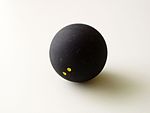
Given the game's vigorousness, players wear comfortable sports clothing and robust indoor (non-marking) sports shoes. In competition, men usually wear shorts and a t-shirt, tank top or a polo shirt. Women normally wear a skirt and a t-shirt or a tank top, or a sports dress. Towelling wrist and head bands may also be required in humid climates. Polycarbonate lens goggles are recommended, as players might be struck with a fast-swinging racket or the ball, that typically reaches speeds exceeding 200 km/h (125 mph). In the 2004 Canary Wharf Squash Classic, John White was recorded driving balls at speeds over 270 km/h (170 mph). Many squash venues mandate the use of eye protection and some association rules require that all juniors and doubles players must wear eye protection.
[Basic rules and gameplay
The court
The squash court is a playing surface surrounded by four walls. The court surface contains a front line separating the front and back of the court and a half court line, separating the left and right hand sides of the back portion of the court, creating three 'boxes' - the front half, the back left quarter and the back right quarter. Both the back two boxes contain smaller service boxes. All of the floor-markings on a squash court are only relevant during serves.
There are four walls to a squash court. The front wall, on which three parallel lines are marked, has the largest playing surface, whilst the back wall, which typically contains the entrance to the court, has the smallest. The out line runs along the top of the front wall, descending along the side walls to the back wall. There are no other markings on the side or back walls. Shots struck above or on the out line, on any wall, are out. The bottom line of the front wall marks the top of the 'tin', a half metre-high metal area which if struck means that the ball is out. The middle line of the front wall is the service line and is only relevant during serves.
Service
Just before the match, the players spin a racket (usually up or down of logo.) to decide who serves first. This player starts the first rally by electing to serve from either the left or right service box. For a legal serve, one of the server's feet must be touching the service box, not touching any part of the service box lines, as the player strikes the ball. After being struck by the racket, the ball must strike the front wall above the service line and below the out line and land in the opposite quarter court. The receiving player can choose to volley a serve after it has hit the front wall. If the server wins the point, the two players switch sides for the following point.
Play
After the serve, the players take turns hitting the ball against the front wall, above the tin and below the out line. The ball may strike the side or back walls at any time, as long as it hits below the out line. It must not hit the floor after hitting the racket and before hitting the front wall. A ball landing on either the out line or the line along the top of the tin is considered to be out. After the ball hits the front wall, it is allowed to bounce once on the floor (and any number of times against the side or back walls) before a player must return it. Players may move anywhere around the court but accidental or deliberate obstruction of the other player's movements is forbidden. Players typically return to the center of the court after making a shot.
Side-out (or Hand-out) Scoring System
This scoring system is based on a “serving” system, in which one must gain the serve to obtain a point. Having the serve is sometimes considered to be on “offense”. The opponent (who does not have the serve) is considered to be on the defensive and must score to win the serve and then score again to gain a point.
Points are awarded if, during the course of play:
- The receiver fails to strike the ball before it has bounced twice
- The receiver hits the ball out (either on or above the out line, or on the tin)
- The receiver fails to hit the front wall with the ball before the ball has bounced
- Stroke: where the receiver obstructs the server during the point (see “Interference and Obstruction”)
Where the server does any of these things, or fails to hit the serve in, then the players change roles and the receiver will serve the next point, but no points are awarded.
Games are played to 9 points (with the exception that the receiver may opt to call "set two" and play to 10 when the score first reaches 8-8). Competition matches are usually played to "best-of-five" (i.e., the player to win the most out of 5 games). At one time this scoring system was preferred in Britain, but also among countries with traditional British ties, e.g. Australia, Canada, Pakistan, South Africa, India, but now at competitive levels, only PARS to 11 is used (see below).
Point a rally scoring system (PARS
Alternatively, in the point-a-rally scoring system (PARS), points are scored by the person who wins each rally, whether or not he or she served. The winner of the previous point will serve at the start of the next point. Traditionally, PARS scoring was up to 9 points (or the receiver calls 9 or 10 when the game reaches 8-8). However, in 2004, the PARS scoring was increased to 11 for the professional game (if the game reaches 10-10, a player must win by two points).[4] PARS is now used on the men's Professional Tour, and the tin height has been lowered by two inches for the men's professional tournaments (these changes have been made in a hope to shorten the length of the rallies and therefore the match). The women's Professional Tour uses the original tin height, but started using the PARS to 11 scoring system as of July 2008. In the International game, club, doubles and recreational matches are usually played using the traditional British scoring system, but the European Squash Federation (ESF), World Squash Federation (WSF) and several national federations are now using PARS to 11 on a trial or permanent basis. Scoring systems and rules can be adapted subtly to accommodate shorter game time or multiple players. As of April 1, 2009, WSF has declared that PARS to 11 will be the only official scoring system allowed for all levels of competitive squash.
Referee
The referee is usually a certified position issued by the club or assigned squash league. The referee has dominant power over the squash players. Any conflict or interference is dealt with by the referee. The referee may also issue to take away points or games due to improper etiquette regarding conduct or rules. Refer to “Interference and Obstruction” for more detail.
Types of shots played
There are many types of shots played that lead to interesting games and strategy.
- Straight drive or 'rail': The ball is hit parallel and close to a side wall to travel deep to the back of the court (the 'basic' squash shot). Often referred to as a 'good length' shot.
- Boast (or angle): The ball is played off a side wall at an angle, or the back wall, before hitting the front wall.
- Volley: The ball is hit 'on the full' (before it touches the floor), usually directly to the front wall
- Drop shot: The ball is hit gently against the front wall, to fall softly to the floor in the front corner.
- Lob: The ball is hit softly and high on the front wall and with a high arc, so that it falls in a back corner of the court.
- Cross Court: The ball is hit to the front wall from the right side to the left (or vice versa).
- Kill: The ball is hit hard and low on the front wall so that it travels no farther than half court.
- Trickle boast: A 'short' boast where the ball is hit to the side wall at the front of the court (often disguised as a drive or drop shot).
- Squeeze boast: A more difficult shot which is hit from the front of the court when the ball is very close to the side wall. Has the same effect as the trickle boast but is more deceptive because of its difficulty.
- Skid boast: The ball is hit high to the side wall near the front wall so that it travels cross court and falls in the opposite back corner.
- Nick shot: the ball is 'volleyed' or hit off a bounce, cross court and with power to strike the front wall then the junction of the side wall and floor (the 'nick'). When hit well, the ball will have little or no bounce or roll along the floor (this is a more advanced shot that is a variation of the kill shot).
- Back wall shot: the ball is hit moderately hard and high off the back wall, so that it goes the length of the room and hits (usually low) off the front wall.
Strategy and tactics
A key strategy in squash is known as "dominating the T" (the intersection of the red lines near the centre of the court where the player is in the best position to retrieve the opponent's next shot). Skilled players will return a shot, and then move back toward the "T" before playing the next shot. From this position, the player can quickly access any part of the court to retrieve the opponent's next shot with a minimum of movement.
A common strategy is to hit the ball straight up the side walls to the back corners; this is the basic squash shot, referred to as a "rail," straight drive, wall, or "length." After hitting this shot, the player will then move to the centre of the court near the "T" to be well placed to retrieve the opponent's return. Attacking with soft or "short" shots to the front corners (referred to as "drop shots") causes the opponent to cover more of the court and may result in an outright winner. Boasts or angle shots are deliberately struck off one of the side walls before the ball reaches the front. They are used for deception and again to cause the opponent to cover more of the court.
Rallies between experienced players may involve 30 or more shots and therefore a very high premium is placed on fitness, both aerobic and anaerobic. As players become more skilled and, in particular, better able to retrieve shots, points often become a war of attrition. At higher levels of the game, the fitter player has a major advantage.
Ability to change the direction of ball at the last instant is also important to unbalance the opponent. Expert players can anticipate the opponent's shot a few tenths of a second before the average player, giving them a chance to react sooner.
Depending on the style of play, it is common to refer squash players[5][6] as
- Power players: squash players who build up their game based on powerful shots. For example, John White.
- Shot makers: squash players who emphasize on shot making. For example, Jonathon Power, Ramy Ashour, Amr Shabana.
- Retrievers: squash players who are excellent on court coverage and retrieving shots. For example, Peter Nicol.
- Atritional players: squash players who play tight shots and base their games on physical strength. For example, David Palmer, Nick Matthew.
Interference and obstruction
Interference and obstruction are an inevitable aspect of this sport, since two players are confined within a shared space. Generally, the rules entitle players to a clear view of the ball after it has struck the front wall, direct straight line access to the ball, room for a reasonable swing and an unobstructed shot to any part of the front wall. When interference occurs, a player may appeal for a "let" and the referee (or the players themselves if there is no official) then interprets the extent of the interference. The referee may elect to allow a let and the players then replay the point, or award a "stroke" to the appealing player (meaning that he is declared the winner of that point) depending on the degree of interference, whether the interfering player made an adequate effort to avoid interfering, and whether the player interfered with was likely to have hit a winning shot had the interference not occurred. An exception to all of this occurs when the interfering player is directly in the path of the other player's swing, effectively preventing the swing, in which case a stroke is always awarded.
When it is deemed that there has been little or no interference, or that it is impossible to say one way or the other, the rules provide that no let is to be allowed, in the interests of continuity of play and the discouraging of spurious appeals for lets. Because of the subjectivity in interpreting the nature and magnitude of interference, the awarding (or withholding) of lets and strokes is often controversial.
When a player's shot hits their opponent prior to hitting the front wall, interference has occurred. If the ball was travelling towards the side wall when it hit the opponent, or if had already hit the side wall and is now travelling directly to the front wall, it is usually a let. However, it is a stroke to the player who hit the ball if the ball was travelling straight to the front wall when the ball hit the opponent, without having first hit the side wall. Generally after a player has been hit by the ball, both players stand still, if the struck player is standing directly in front of the player who hit the ball he loses the stroke, if he is not straight in front, a let is played. If it is deemed that the player who is striking the ball is deliberately trying to hit his opponent, he will lose the stroke. An exception to all of this occurs when the player hitting the ball has "turned", i.e., let the ball pass him on one side, but then hit it on the other side as it came off the back wall. In these cases, the stroke goes to the player who was hit by the ball.
There are several variations of squash played across the world. In the U.S. hardball singles and doubles are played with a much harder ball and different size courts (as noted above). Hardball singles has lost much of its popularity in North America (in favour of the International version), but the hardball doubles game is still active. There is also a doubles version of squash played with the standard ball, sometimes on a wider court, and a more tennis-like variation known as squash tennis.
The relatively small court and low-bouncing ball makes scoring points harder than in its American cousin, racquetball, as the ball may be played to all four corners of the court. Since every ball must strike the front wall above the tin (unlike racquetball), the ball cannot be easily "killed". As a result, rallies tend to be longer than in racquetball.
Squash provides an excellent cardiovascular workout. In one hour of squash, a player may expend approximately 600 to 1000 calories(3,000 to 4,000 kJ),[7] which is significantly more than most other sports and over 70% more than either general tennis or racquetball. The sport also provides a good upper and lower body workout by utilising both the legs to run around the court and the arms and torso to swing the racquet. In 2003, Forbes rated squash as the number one healthiest sport to play.[7] However, some studies have implicated squash as a cause of possible fatal cardiac arrhythmia and argued that squash is an inappropriate form of exercise for older men with heart disease.[8]
Squash around the world
According to the World Squash Federation, as of June 2009, there were 49,908 squash courts in the world, with 188 countries and territories having at least one court. England had the greatest number at 8,500. The other countries with more than 1,000 courts, in descending order by number were Germany, Egypt, the United States of America, Australia, South Africa, Canada, Malaysia, France, the Netherlands, and Spain.[9]
As of June 2009, there were players from nineteen countries in the top fifty of the men's world rankings, with Egypt and England leading with eleven each.[10] The women's world rankings featured players from sixteen countries, led by England with eleven.
The men's professional squash tour and rankings are run by the Professional Squash Association (PSA). The equivalent body for women is the Women's International Squash Players Association (WISPA).
Players and records
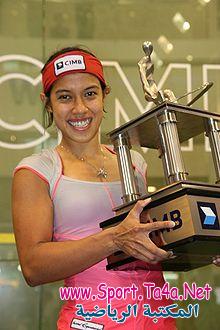
The (British) Squash Rackets Association (now known as England Squash & Racketball) conducted its first British Open championship for men in December 1930, using a "challenge" system. Charles Read was designated champion in 1930, but was beaten in home and away matches by Don Butcher, who was then recorded as the champion for 1931. The championship continues to this day, but has been conducted with a "knockout" format since 1947.
Since its inception, the men's British Open has been dominated by relatively few players:F.D. Amr Bey (Egypt) in the 1930s; Mahmoud Karim (Egypt) 1940s; brothers Hashim Khanand Azam Khan (Pakistan) 1950s and 1960s; Jonah Barrington (Great Britain and Ireland) and Geoff Hunt (Australia) 1960s and 1970s; Jahangir Khan (Pakistan) 1980s; and Jansher Khan (Pakistan) 1990s.
The women's championship started in 1921, and has similarly been dominated by relatively few players: Joyce Cave and Nancy Cave (England) in the 1920s; Margot Lumb (USA) 1930s; Janet Morgan (England) 1950s; Heather McKay (Australia) 1960s and 1970s; Vicki Cardwell (Australia) and Susan Devoy (New Zealand) 1980s; Michelle Martin (Australia) 1990s; and Sarah Fitz-Gerald (Australia) 1990s and 2000s.
Heather McKay, with her lengthy and absolute dominance of the game (she remained undefeated for 18 years during the 1960s and 1970s), is undoubtedly the greatest woman player of all time.
Because of its traditions, the British Open has been considered by many to be more prestigious than the World Open, which began in the mid-1970s. However, some have shown concern about the ability of the former to sustain its prominence, citing its failure in 2005 to attract top players, probably due in part to the disparity in prize money. In 2005 the combined men's and women's prize money for the British Open came to $71,000, compared with the 2005 World Open's prize money, estimated to be about $270,000.
Previous world number one Peter Nicol stated that he believed squash had a "very realistic chance" of being added to the list ofOlympic sports for the 2016 Olympic Games,[11] but it ultimately lost out to golf and rugby sevens.
The current number 1 rank is held by Ramy Ashour of Egypt in the men's competition[12] and Nicol David of Malaysia in the women's competition.[12] Currently there is no international standard method (other than for professional players) for evaluating skill levels for players.
Wider acceptance
Squash has been featured regularly at the multi-sport events of the Commonwealth Games and Asian Games since 1998. Squash is also a regular sport at the Pan American Games since 1995. However it is still not recognized as an Olympic sport. Squash players and associations have lobbied for many years for the sport to be accepted into the Olympic Games, with no success to date. Squash narrowly missed being instated for the 2012 London Games. It was again up for consideration for the 2016 Summer Games along with baseball, softball, rugby sevens, karate, golf, and roller sports, but squash again missed out as the IOC assembly decided to add golf and rugby sevens to the Olympic programme.[13]
Squash is played throughout the world, and is similar to tennis in skills and fitness requirements, but the principal limitation has always been the difficulty in observing the sport as a spectator, either in person or on television. The ball travels so quickly that television audiences are hard-pressed to follow the action, even though some tournaments have attempted to remedy the problem by using a specially coated ball for increased visibility. To maximise the viewing audience at tournaments, promoters often use an all-glass court that is designed to permit spectators to be seated around all four walls but is specially tinted so as not to distract the players. Because of these viewer restrictions, professional squash players earn vastly less than their counterparts in the tennis world.
Popular culture
The 1980 novel Boast by Miles Donald revolves around the game of squash.
In David Lean's Lawrence of Arabia a staff officer tells Lawrence about the new squash court at GHQ in Cairo when Lawrence asks what has been happening at base while he has been in the desert leading the Arab revolt.
In the TV sitcom Frasier, squash was a game Frasier and his brother Niles would play.
Ryan O'Neal plays a game of squash in Love Story.
In the movie Half Moon Street Sigourney Weaver plays squash at a Swiss resort.
In the movie Wall Street, Gordon Gekko (Michael Douglas) and Bud Fox (Charlie Sheen) play a game of squash.
In the television series Gossip Girl, the characters Chuck Bass and Marcus Beaton play a game of squash at Chuck's father's club.
In the television series Friday Night Lights, Coach Eric Taylor and "Smash" Williams play a game of squash, which Smash describes as the "whitest sport ever".
In the television series Green Wing, Mac and Guy Secretan play a game of squash in the episode "Emergency". Guy is equipped with appropriate squash gear, while Mac is left playing in his surgical scrubs with a ping-pong paddle.
In the novel Digital Fortress by Dan Brown David Becker's hobby is playing squash.
In the film The Game Micheal Douglas' character, Nicholas Van Orton plays squash by himself at mens' club. The court's walls are made of dark wood.
In the film Shallow Grave the main characters play each other at squash.
In the 2005 novel Saturday by Ian McEwan, Henry Perowne plays a regular weekly squash game.
In the John Irving novel A Widow for One Year the character Ruth Cole plays squash and defends herself against an assault on the squash court.
In the John Irving novel The World According to Garp the character T.S. Garp plays squash with Roberta.
In 2009, the first and only[citation needed] squash 3D video game, Touch Squash, was launched on the iPhone App Store for iPhone andiPod touch.
Squash is a minigame from Super Monkey Ball: Banana Blitz, released as a launch title on the Wii in December 2006.
A simplified version of squash appears as a bonus minigame in Tiny Toon Adventures: Buster Busts Loose!.
British comedy duo The Two Ronnies did a sketch in 1983 where Ronnie Corbett plays an experienced squash player who gets thrashed by newcomer Ronnie Barker.
In the 2000 movie American Psycho, Timothy Bryce (played by Justin Theroux) invites his colleagues to play a game of squash.
Comedy group The Kids in the Hall poked fun at the game's competitiveness by introducing a costumed player character named the Eradicator.
In the 2005 movie Syriana, the character Sydney Hewitt plays squash with Bennett Holiday.
In the 2002 Friends episode "The One With The Male Nanny," the character Ross Geller reveals that he plays Squash.
In 2009, New Zealand TV Show Shortland Street featured characters Dr Warner and Scotty playing a game of squash during a lunch break.
- rieved 2 March 2010.
References
- Bellamy, Rex (1978). The Story of Squash. Cassell Ltd, London. ISBN 0-304-29766-6.
- Palmer, Michael (1984). Guinness Book of Squash. Guinness Superlatives Ltd, London. ISBN 0-85112-270-1.
- Hickok, Ralph (25 September 2008). "Squash Rackets Rules". Hickok Sports. Retrieved 17 November 2008.
- "Squash Site".
- "Learn Sport".
Further reading
- Satterthwaite, Frank (1979). The three-wall nick and other angles : a squash autobiography. New York: Holt, Rinehart, and Winston.ISBN 0030166667.
- Zug, James; Plimpton, George, Squash: a history of the game, New York : Scribner, 2003. ISBN 0-7432-2990-8

برجاء ذكر المصدر حتى تعم الفائدة :المكتبة الرياضية الشاملة : Squash
المقالات التي قد تهمك أيضا:
